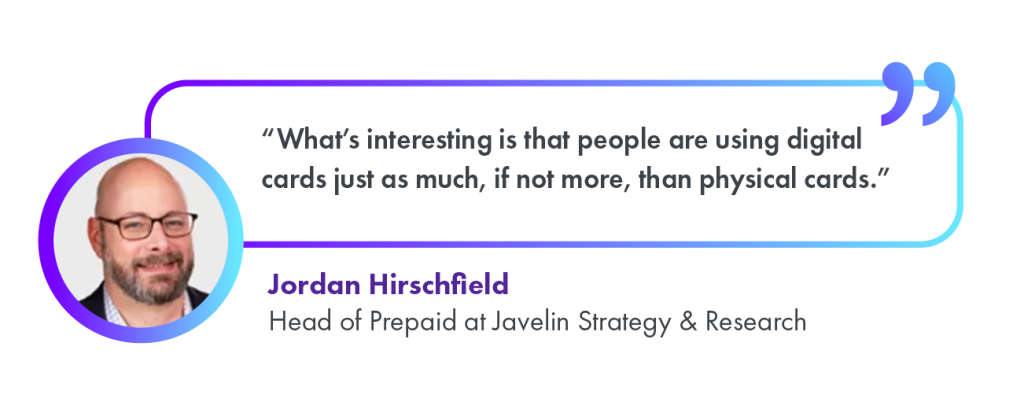Gift cards may have a bad rap for accumulating in wallets and drawers unused, but don’t call time of death just yet. Riding a digital wave of innovation, the gift card industry is as healthy as ever. But exactly how big is the gift card industry? And what is the outlook for the gift card industry in 2024?
Valued at $1,128 billion in 2023, the global gift card market is hurtling towards an estimated market size of $4.4 trillion in the next 8 years, reports research firm Expert Market Research.
Source: Expert Market Research
Big drivers of this growth are the increasing penetration of online shopping platforms and e-commerce sector together with accelerating adoption of digital gift cards.
To better understand why digital gift cards – and gift cards in general – are so popular in 2024, this gift card industry analysis examines the current state of the market and its outlook.
We explore the markets, segments demographics, and major players to better understand what gift card strategy best fits your business.
Read on to learn the ins and outs of the gift card industry.
Who doesn’t love a good gift card? Sign up for Reloadly and learn how our gift card API and easy plugin integration can build a reliable long-term revenue stream for your business.
The gift card market analyzed per region
At a forecasted compound annual growth rate or CAGR of 16.3%, the global gift card market is in for a decade of substantial growth.
To put this in perspective, the market growth could outpace what the World Bank predicts to be a lackluster global economy by over 7 times through 2030. But how big is the gift card industry per region? And which regions show the highest growth rates?
Sources: Expert Market Research; Global Industry Analysts; Data Bridge Market Research; PayNXT360; Credence Research
North America
The mature North American gift card market accounts for one third or 38% of the global industry, according to research firm Global Industry Analysts. Extrapolating this to the earlier mentioned numbers from Expert Market Research, this puts the US and Canada at an estimated market size of $428 billion as of 2023.
The rise of the US market can be attributed to factors such as the increasing use of gift cards by millennials and Gen Z customers, the development of digital gift cards, and the growth of e-commerce activity.
With a competitive landscape and high usage rates of gift cards, the US market is showing signs of saturation with slower growth than the global gift card industry at 8% annually through 2029, research firm Mordor Intelligence forecasts.
In contrast, developing markets represent massive growth opportunities with soaring year-on-year expansion.
The Middle East and Africa
A fast developing region with growing consumer markets, Africa and the Middle East represent only a small fraction of the global gift card market today – but a lot of potential for businesses to adopt gift card strategies.
Estimated at USD 66.2 billion by research firm PayNXT360, the region would represent around 6% of the global market size. The Middle East and Africa region is expected to grow at a CAGR of 15.3% during the forecast period of 2023-2030, a market report from research firm Straits Research predicts.
The market’s expansion is fueled by the adoption of digital payment solutions, a rising disposable income, and an expanding consumer base. Additionally, the thriving tourism industry and the cultural tradition of gift-giving further contribute to the growth of the gift card market in the MEA region.
Asia Pacific
Another region showing fast market growth is the Asia-Pacific region. The region is estimated at $246 billion in 2023 and promises a CAGR of 14.9% through 2030, according to a market report by analysts Data Bridge Market Research. This would represent a market share of roughly 23% of the global gift card industry.
This rapid growth is attributed to growing internet penetration and disposable income. Gifting, from the holiday season to corporate occasions, also contributes to the demand for gift cards, according to the mentioned market report by Straits Research.
Furthermore, an increase in retail business is expected to boost market growth. Several e-commerce giants such as Amazon, eBay, and Alibaba help fuel the market growth.
Gift card vendors have started investing in the Asia Pacific region due to improved ICT infrastructure in countries like China, South Korea, India, Malaysia, Australia, and Japan, which are expected to create ample opportunities for the gift cards market growth in the region.
Europe
At a market share of 28% of the global gift card market, Europe is a considerable market. As the second-largest market for gift cards, it promises considerably more market growth than North America.
The European gift cards market is projected to grow at a Compound Annual Growth Rate (CAGR) of 14% during the forecast period of 2022-2030, analysts at Credence Research forecast.
Germany currently dominates the European Gift Cards Market, holding over 27.50% of the market share in 2022. France and Italy are promising markets, too, showing higher growth rates than other European countries.
A significant trend within Europe is the use of gift cards by businesses as a token of recognition for employees’ contributions. This show of appreciation is deeply ingrained in the European corporate culture, and about 60% of European companies are incorporating gift cards into their employee reward programs.
Key gift card market segments
Gift cards are prepaid cards that are preloaded with a certain amount of money and can be used as a form of payment at specific stores, websites, or restaurants that accept that particular card. However, not all gift cards are equal.
There are two main types of gift cards: closed-loop cards, which are specific to a particular store or brand, and open-loop cards, which can be used at a variety of retailers and online merchants.
Closed loop vs open loop gift cards
The closed-loop gift card segment currently holds the highest market share, accounting for more than two-thirds of the global gift card market revenue in 2022, a market report by research firm Allied Market Research shows.
Source: Allied Market Research
Closed-loop gift cards are popular because they offer a convenient and straightforward gift option, usable at a specific store without the need for cash redemption. By providing them, companies boost brand recognition and customer loyalty, as customers associate the card directly with the brand.
But while closed-loop gift cards are thought to retain their dominance throughout the forecasted period, the open-loop gift card segment is projected to show the highest growth rate (CAGR) of 20.8% from 2023 to 2032.
So what is the outlook for the gift card industry? Gaining a significant increase in market share over the market forecast period, open-loop gift cards are set to eventually dominate the gift card market if this market trend continues.
Apart from freedom of use versus being only valid at one retailer, open-loop gift cards offer several benefits for businesses, contributing to their significant growth in the gift card market. Some of these benefits include:
- Incentives and Rewards: Serve as powerful tools to boost consumer loyalty, increase sales, and enhance employee morale. Personalization with the business’s branding reinforces brand awareness.
- Tracking and Monitoring: Enable easy tracking and monitoring, enhancing accountability and efficiency in incentive usage for businesses.
- Security and Efficiency: Widely adopted for their security, efficiency, reliability, and flexibility in electronic payments, open-loop cards are favored by both consumers and businesses.
- Universal Acceptance: Accepted anywhere that takes the associated credit card network (e.g., Visa or Mastercard), making them a versatile and widely accepted payment option.
Digital gift cards vs physical gift cards
Other than segmentation by card type, the gift card market can be divided between physical gift cards and digital or e-gift cards.
E-gift cards now account for 48% of total gift card spending compared to their physical counterparts, a KPMG industry survey on gift cards reports.
In another research report, digital gift cards account for 40% of total value. Jointly written by gift card giant Blackhawk Network and market researcher NAPCO Research, the report sees digital gift cards gaining ground in the coming years.
Jordan Hirschfield, Head of Prepaid at Javelin Strategy & Research, even argues that digital gift cards are already used as much as physical gift cards, but this isn’t reflected in the market value.
“Currently, the average value of digital cards is slightly lower, around $30, compared to physical cards,” Hirschfield said. “However, what’s interesting is that people are using digital cards just as much, if not more, than physical cards.”

Currently, the digital gift card market is experiencing growth due to 4 key factors:
- Technological advancement and innovations in the payments industry.
- Increased awareness of digital payments among consumers.
- Surge in penetration of smartphones enabling the use of digital gift cards.
- Rise of e-commerce allows for seamless integration with online transactions.
Technological advancements
Three major tech advancements will define the gift card market in 2024. First, the increased allowance for customization and personalization of digital gift cards empowers users to include personalized messages, images, or videos. This elevates the gifting experience and resonates with consumers seeking a more tailored approach.
A second key development is the integration of robust encryption techniques to safeguard against fraud and unauthorized usage, instilling further growth in the market.
Increased awareness of digital payments
Consumers show increasing awareness of digital payments, transforming how they engage in transactions. The simplicity and contactless nature of digital gift cards contribute to their popularity as a preferred payment method.
In 2021, 82% of Americans adopted digital payments, reflecting the widespread use of in-store mobile phone checkout, QR code payments, and online transactions, analysts at Business Research Company reported.
Surge in penetration of smartphones
The rapid penetration of smartphones has been a key driver for the digital gift card market, as it has increased the accessibility and convenience of using digital gift cards.
The proliferation of mobile apps has played a pivotal role in expanding the digital gift card market. Mobile apps provide seamless access to digital gift cards, enabling users to effortlessly purchase, store, and redeem them on their smartphones, thereby fostering increased adoption
Rise of e-commerce
Another major contributing factor to the rise of digital gift cards is the growing popularity of online shopping. After an initial surge in online retail during the pandemic, online shopping has kept growing in market share over offline retail, a report from data platform Statista shows.
Source: Statista
The ascent of e-commerce platforms has provided a substantial impetus to the digital gift card market. Online shoppers enjoy seamless integration of digital gift cards with their online retail experience.
Furthermore, e-commerce companies and retailers use e-gift cards as a marketing strategy to promote their brands, Mordor Intelligence concludes.
GIft cards according to consumers
Digitalization, mobile penetration, and e-commerce – all are factors adding to a booming gift card market. In essence, though, gift cards work across time, tech, and markets. Why? Consumers love gift-giving – especially during the holiday season.
A whopping 72% of Americans plan to give gift cards and 91% enjoy receiving them, according to a 2022 survey by financial advisor Credit Summit.
US consumers seem to have put their money where their mouth is, with an estimate for the 2023 holiday spendings on gift cards to have reached $29.3 billion, estimated the National Retail Federation.
However, purchased gift cards don’t necessarily mean redeemed gift cards. In 2023, nearly half (47%) of U.S. adults had at least one unused gift card, gift voucher, or store credit, according to an industry survey on gift cards held by financial company Bankrate.
The average value of these unused gift cards is $187 per person, totaling $23 billion nationwide. Moreover, the average value of an unused gift card went up from $175 in 2022 and $116 in 2021.
When broken down by generations, Gen Xers are sitting on the highest average value on unused gift cards:
- Gen Xers: $251 per person
- Millennials: $198 per person
- Gen Zers: $168 per person
- Baby boomers: $145 per person
This could indicate that Boomers are most likely to use their gift cards, whereas Gen Xers are less likely to use them.
In another market report, millennials and Generation Z show increasing demand for gift cards. These demographic groups show a strong preference for the convenience and flexibility of both digital and physical gift cards, Credence Research reports.
Who are the key players in the gift card industry?
Most of the key players in the gift card industry operate in the classic industries for gift cards. These market players include Amazon.com, Inc., American Express Company, Blackhawk Network Holdings, Inc., Fiserv, Inc., Givex Corporation, InComm Payments, PayPal, Inc., Paytronix Systems, Inc., Qwikcilver Solutions Pvt Ltd., and Walmart Inc.
The above companies offer some of the most popular gift cards in the gift card market and have gained significant market share for various reasons.
Companies like Amazon.com, Inc have been at the forefront of the e-commerce rise and their gift card products have skyrocketed along with their online shopping platform.
Operating in one of the classic industries for gift cards, Walmart’s gift cards are widely used because of their extensive physical presence in the US market and wide range of budget-friendly products. Consequently, Walmart’s gift cards are accessible to a wide range of consumers.
PayPal, on the other hand, is a market leader in digital payments. Their payment platform is widely used for online payments. The company is therefore exceptionally well-positioned to operate a digital, open-loop gift card program.
Conclusion: adopting a fitting gift card strategy
The gift card industry is undergoing a transformation catalyzed by the accelerating adoption of digital payments, the rise of e-commerce, and shifting consumer preferences.
As explored in this analysis, the global gift card market is growing towards a valuation of $4.4 trillion by 2030 on the back of double-digit growth rates and comfortably outpacing global GDP expansion.
E-gift cards now claim almost half of total gift card spend, and their growth is fueled by convenience, security improvements, smartphone proliferation allowing mobile access and payments, and seamless integration with online shopping.
These market dynamics point to a distinctly digital future for the industry. However, physical gift cards retain dominance in specific markets like the U.S. while closed-loop options drive loyalty and repeat sales for individual brands.
Businesses exploring gift card opportunities should try to capitalize on the rise of new technologies and shifting consumer behavior through smart use of gift cards can create a competitive edge. Gift-giving traditions and expanding consumer classes offer ideal conditions to rollout gift card programs localized to regional nuances.
Gift cards build brand loyalty. Are you ready to see how our next-generation gift card can increase engagement and revenue? Sign up for Reloadly or contact us to learn how our digital gift card API lets you transfer open-loop gift cards to people worldwide.



